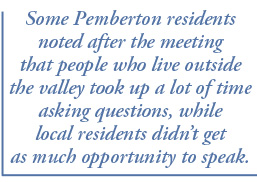
Scores of concerned Pembertonians, and others, descended upon the old Pemberton Community Centre Thursday night to express their opinions about a proposed run-of-river project on the Ryan River.
Many of those present didn’t have to speak to let their opinions be known — they wore nametags that read “No DAM way” and brought signs that read, “Keep the Ryan Wild” and “Stop the Ryan Ru(I)n of River Project.” Others concerned about what they see as threats to wildlife, held pictures of fish and grizzlies.
Throughout the meeting comments from the audience ranged from questions about the privatization of B.C. rivers to outright accusations of theft.
Some Pemberton residents noted after the meeting that people who live outside the valley took up a lot of time asking questions, while local residents didn’t get as much opportunity to speak.
The meeting was part of the public consultation process overseen by the Environmental Assessment Office (EAO). That’s a joint office of the federal and provincial governments that brings together all departments and permitting agencies that review a run of river project before an environmental assessment can move forward.
The Ryan River project currently lies within the “Information Requirements for Application” phase. It’s the second of eight phases in the EAO’s review process.
The current phase, which includes accepting public comments on the project, will conclude Dec. 15. The next phase involves preparing and submitting an application to the EAO.
Regional Power Inc., a Toronto-based subsidiary of Manulife Financial, wants to establish a 145-megawatt run-of-river power plant on the Ryan River. The project will have a powerhouse with three to five turbine generators. Some of the river water will be diverted through a 9.5-km tunnel that will be burrowed through Sugarloaf Mountain.
The water will then enter the powerhouse at the end of the tunnel. A 26.5-km transmission line will carry the electricity from the Ryan River to a substation located near the Rutherford Creek Hydro Project powerhouse.
Electricity generated at the Ryan River plant will be fed into the Western Interconnection, a power grid that distributes electricity in Western North America, over the Rocky Mountains in Canada and south to Baja California in Mexico.
A unique feature of the project will be a man-made salmon habitat that will increase the fish population in the Ryan River, according to Nigel Protter, the principal of Exergetics Development Co. and a consultant who providing information about the project to Pemberton and surrounding communities.
In 2005 Regional Power Inc. won the UNESCO/International Hydropower Association Blue Planet Prize for “social, environmental and technical excellence” demonstrated at its Sechelt Creek hydropower project. The project helped re-establish a salmon run in the creek.
Regional Power expects to do the same thing with the Ryan, re-establishing a salmon run that was devastated in the mid-20th century by dyking along the river, said Protter.

“Where the Ryan pours into the valley, that has historically been a very significant salmon breeding and brooding habitat,” he said in an interview. “We'll build back a strong, bio-diverse Coho salmon and bull trout population, but mostly Coho in there, and it's going to be an amazing thing.”
The project has nevertheless been controversial, both within and outside Pemberton. Dozens of protesters attended Thursday’s meeting, some of them from Pemberton but others from various organizations including the Western Canada Wilderness Committee and the Save Our Rivers Society.
Protesters first directed their rage at Derek Griffin, who delivered a presentation on the EAO’s environmental review process.
Joe Foy of the Western Canada Wilderness Committee, who is not a Pemberton resident, was the first to query him.
“There are literally hundreds of these things (run of river hydro projects) being proposed across B.C., and well over 100 in this area,” he said. “Will this process look at the cumulative impact on the fish and wildlife in the area, if all these things go forward, or will this process simply look at this one?”
Griffin responded that the cumulative effects of the Ryan River project would be assessed as part of the EAO’s review process, but he couldn’t speak to specifics regarding other projects in the area.
“Many of those applications are not applications to our process,” he said. “They are applications for water licenses and a number of those projects may be large enough to warrant projects in our process. “My understanding is that most of those projects have not proceeded very far along in terms of the water licensing and land itinerary process, and it’s very difficult for us to know right now how many of those are likely to come forward.”
Despite what Griffin said about the progress of other run-of-river projects in the area, Whistler resident and activist Pina Belperio expressed concern that “110 of these projects” could be built in the Sea to Sky corridor and there wouldn’t be enough time to do a full environmental assessment of them.
“I had the opportunity to meet somebody who works at the Ministry of the Environment in the water department, and she confirmed to me that most of you guys have about 15 to 20 minutes allotted for a project, for the assessment process,” she said.
“I’m just wondering how much time you’re allocating towards the environmental process.”
Griffin said he couldn’t comment on how much time government agencies have for environmental assessment reviews. He did, however, say that “weeks of work” has already been put into the review of this project and others.
Hamish Nichol, a Pemberton resident and activist with B.C.’s Save Our Rivers campaign, asked whether there’s an opportunity for the public to say “no” to a project during the EAO review process.
“Is there any way, for example at this meeting tonight, we could say no to this process, and anyone would pay attention to it?”
Many in the audience applauded his question.
Griffin, looking visibly nervous, said that any member of the public is as “free as everybody here” to make their views known about the project through the EAO process — but the public comment period ends Dec. 15.
“The environmental assessment legislation is developed in a way that offers the proponent an opportunity to put forward what they think is a good project,” Griffin said.
Griffin was dogged with several more questions before turning it over to David Carter, executive vice-president of Regional Power, who showed a video and gave an overview of the Ryan River project.
Carter told the audience that the Ryan River has been “adversely impacted” by human activity and said he wants to bring fish back “in large numbers” to the watershed. He drew on Regional Power’s experience developing the Sechelt Creek project, which he said brought grizzlies back to the area.
“With the fish, you bring back the grizzlies; with the grizzlies, you bring back the eagles and so forth,” he said.
An audience member with a video camera then interrupted and accused Carter of lying to the public.
“We’re not talking about Sechelt Creek, we’re talking about the Sea to Sky Land and Resource Management Plan,” he said, drawing attention to a plan that identifies the entire Sea to Sky corridor — not just the Ryan River — as a grizzly bear recovery area.
Another audience member asked the cameraman to let Carter finish talking and then called him a “turkey.”
At one point Foy asked Carter, “How many people have to say no to make you go away?”